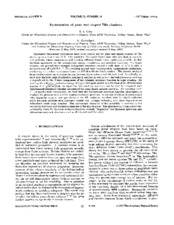| dc.creator | Chin, Siu A. | |
| dc.creator | KROTSCHECK, E. | |
| dc.date.accessioned | 2012-09-19T20:00:34Z | |
| dc.date.available | 2012-09-19T20:00:34Z | |
| dc.date.issued | 1995 | |
| dc.identifier.citation | Siu A. Chin and E. KROTSCHECK. Phys.Rev.B 52 10405-10428 1995."Copyright (1995) by the American Physical Society." | en |
| dc.identifier.uri | http://dx.doi.org/10.1103/PhysRevB.52.10405 | |
| dc.identifier.uri | https://hdl.handle.net/1969.1/146766 | |
| dc.description | Journals published by the American Physical Society can be found at http://journals.aps.org/ | en |
| dc.description.abstract | Optimized variational calculations have been carried out for pure and doped clusters of He-4 atoms up to a cluster size of N=1000 particles. For small cluster sizes with less than or equal to 112 particles, where comparisons with existing diffusion Monte Carlo results are possible, we find excellent agreement for the ground-state energy, correlation, and structure functions. For larger clusters, our ground-state energies extrapolate smoothly toward a bulk limit of -7.2 K with a surface energy of 0.272 K Angstrom(-2). The resulting ground-state densities show unmistakable oscillations, confirming our earlier conclusions based on diffusion Monte Carlo studies. The present study of large clusters allows us to bridge the gap between finite systems and the bulk limit. Specifically, we show how the bulk limit of collective energies is reached as well as how the bulk Feynman spectrum is reproduced in the S-wave component of the dynamic structure function in large droplets. By plotting the collective excitation energy of higher multiple modes as a function of an effective wave number K = root l(l+1)/R, we show that the resulting spectrum can be directly compared with experimental excitation energies determined for plane liquid surfaces and films. By summing up to l = 50 partial wave components, we show that the full dynamic structure function simultaneously displays the phonon-roton and the ripplon excitation spectrum. In the case of helium droplets doped with impurities such as rare gas atoms or the SF6 molecule, we show that the dipole collective mode becomes unstable with increased droplet size, strongly indicating that these impurities are delocalizled inside large droplets. The microscopic character of the instability is revealed in the excitation functions and transition densities of the dipole mode. The introduction of impurities also profoundly alters the dynamic structure function, severely ''fragments'' the Feynman spectrum, and obliterates landmark structures such as the maxon and the roton. | en |
| dc.language.iso | en | |
| dc.publisher | American Physical Society | |
| dc.rights | This work is archived in the Texas A&M Digital Repository with the express permission of the rights holder (commonly but not always the publisher). A copy of the permission document is on file with the Texas A&M University Libraries. | en |
| dc.subject | HELIUM CLUSTERS | en |
| dc.subject | COLLECTIVE EXCITATIONS | en |
| dc.subject | GROUND-STATE | en |
| dc.subject | INFRARED-SPECTROSCOPY | en |
| dc.subject | CONDENSATE FRACTION | en |
| dc.subject | SUPERFLUID HE-4 | en |
| dc.subject | LIQUID-HELIUM | en |
| dc.subject | MONTE-CARLO | en |
| dc.subject | FILMS | en |
| dc.subject | SURFACE | en |
| dc.subject | Physics | en |
| dc.title | Systematics of Pure and Doped He-4 Clusters | en |
| dc.type | Article | en |
| local.department | Physics and Astronomy | en |


